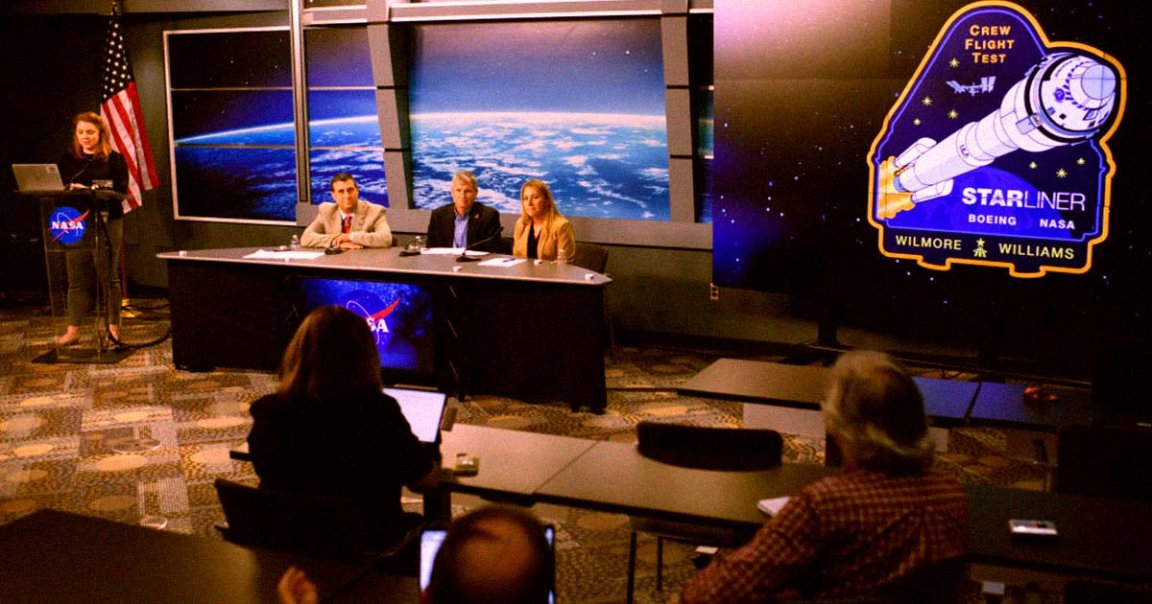
Moments after midnight on Saturday morning, Boeing’s much-maligned Starliner spacecraft completed its descent over the New Mexico desert.
After undocking from the International Space Station about six hours earlier, the capsule pulled off a smooth return to Earth, albeit without stranded NASA astronauts Butch Wilmore and Suni Williams on board.
“A safe and successful landing is exactly what we wanted,” NASA’s Space Operations Mission Directorate deputy associate administrator Joel Montalbano proudly told reporters during a post-landing press conference. “We did learn a lot.”
But noticeably absent from the proceedings was Boeing. According to Ars Technica‘s Eric Berger, Boeing vice president and Space Launch System program manager John Shannon, as well as Boeing’s Commercial Crew program manager Mark Nappi, were scheduled to attend the presser at NASA’s Johnson Space Center.
“It’s seemingly a last-minute change because there were five chairs set up at the news conference,” Berger tweeted, “and they just removed two seats right now.”
When he asked NASA about the reason for Boeing’s absence, he said, the agency’s response was “you’ll have to ask them.”
Needless to say, Starliner’s disastrous first crewed flight attempt has strained the relationship between NASA and its longtime contractor Boeing. Even NASA’s commercial crew program manager Steve Stich admitted last week that there was “some tension in the room” as the agency moved to return the spacecraft without its crew due to safety concerns.
According to sources who spoke with the New York Post last month, meetings were often “heated” and led to execs yelling and arguing.
“Boeing wasn’t happy,” a NASA source told the newspaper at the time. “And they made that perfectly clear to us. But what’s the headline if there’s a catastrophic failure? It’s not ‘Boeing killed two astronauts,’ it’s ‘NASA killed two astronauts.’ So no, it’s better safe than sorry.”
In the end, despite a failing thruster and a glitching navigation system, Starliner performed a “bullseye landing,” as Stich told reporters over the weekend. “The entry in particular has been darn near flawless.”
That praise makes Shannon and Nappi’s sudden absence all the more intriguing. After many months of bad press, why wouldn’t Boeing’s representatives use the golden opportunity to sing Starliner’s praises? (In reality, the spacecraft did run into several new issues during its return, which the execs might have been concerned about getting widespread attention.)
As Ars reports, Boeing instead emailed reporters a terse statement shortly after Starliner’s landing.
“I want to recognize the work the Starliner teams did to ensure a successful and safe undocking, deorbit, re-entry and landing,” Nappi said in the statement. “We will review the data and determine the next steps for the program.”
A glaring question: to what degree is Boeing still committed to its Starliner program? Analysts have long suggested that the company may divest after losing well over a billion dollars on the project.
Should Shannon and Nappi’s refusal to attend the proceedings — according to Berger, they were at the Johnson Space Center ready to attend — be counted as a vote of no confidence? Or is Boeing playing it as safe as possible by laying low until it has decided to either walk away or double down on Starliner?
While Boeing is hard to read, NASA remains outwardly confident that the spacecraft still has a future. Given the many billions of dollars it has committed to the project, that shouldn’t come as much of a surprise.
“The Boeing managers came into the control room and congratulated the team, talked to the NASA team, so Boeing is committed to continue their work with us,” Montalbano told reporters.
Where any of this leaves Starliner’s actual prospects remains to be seen.
“It’ll take a little time to determine the path forward, but today we saw the vehicle perform really well,” Stich told reporters.
“It’s great to have the spacecraft back, and we’re now focused on Starliner-1,” he added, referring to the first official crew rotation mission to the ISS — which could still be several years out.
More on Starliner: Starliner Suffers New Problems While Coming Back to Earth